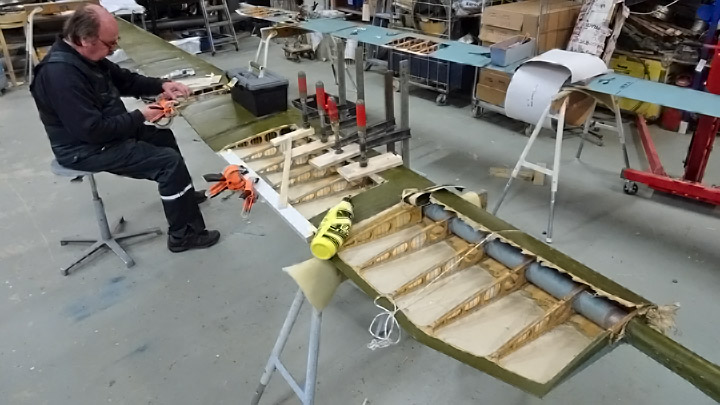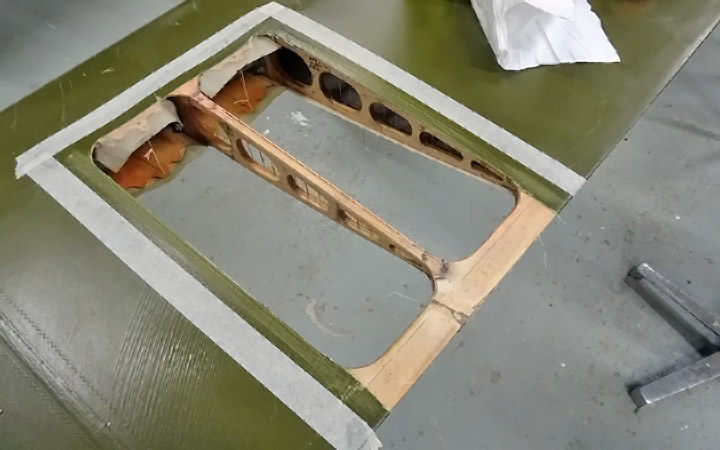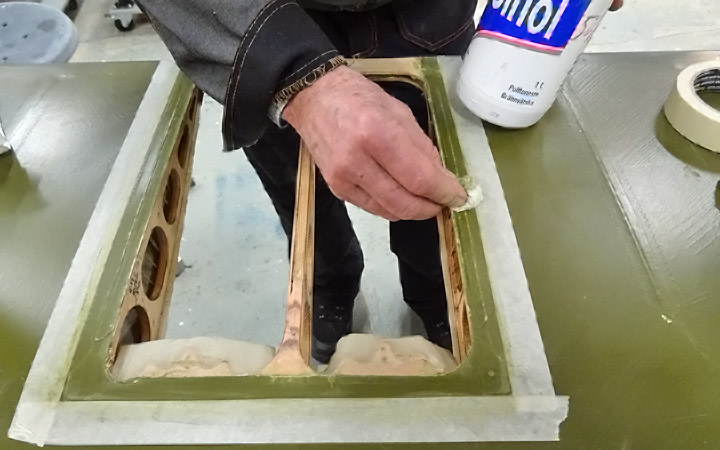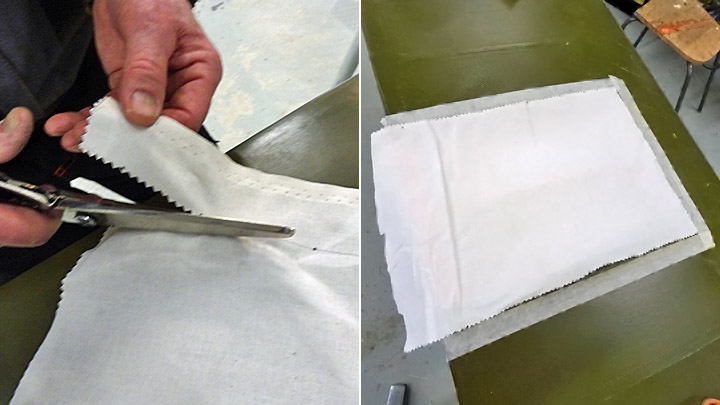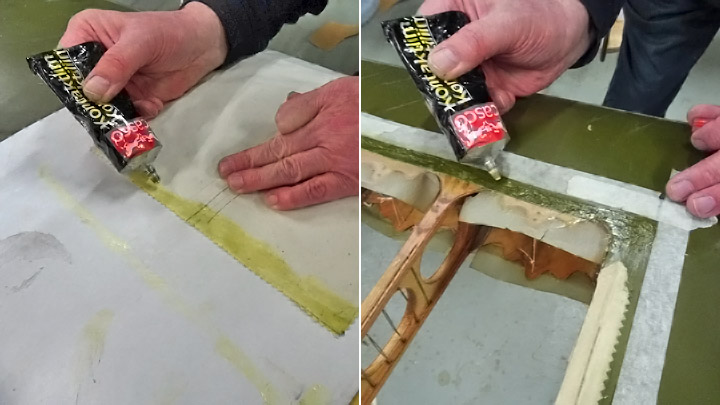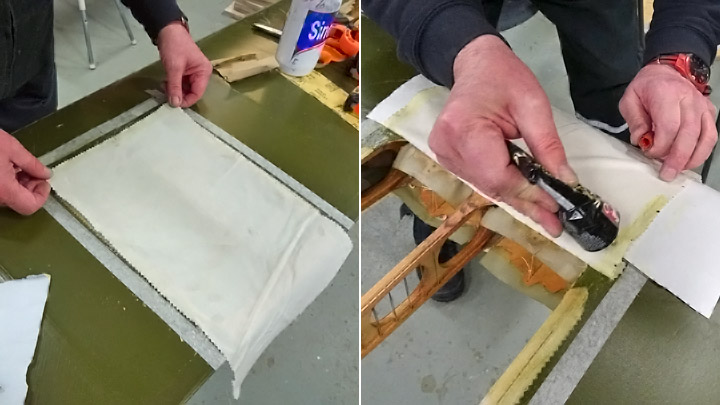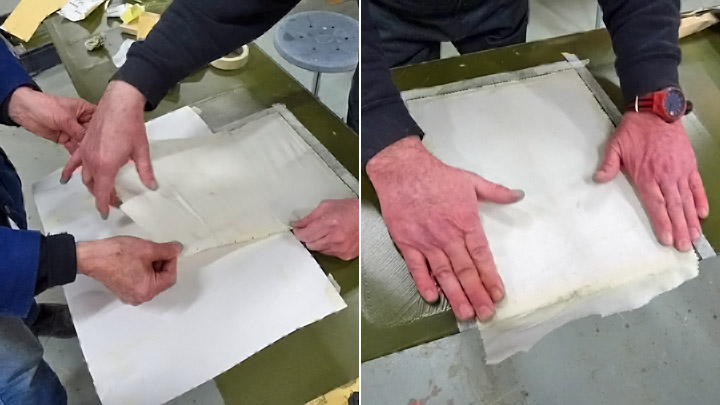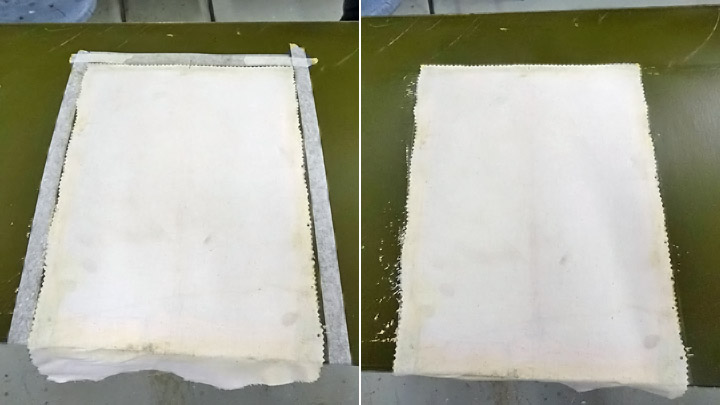Fabric covering of SM-1 rotor blade is patchedTiistai 12.3.2019 - Member of Tuesday Club The repair of the SM-1 helicopter’s (HK-1) two rotor blades (No1 and No3) has been going on for about a month. The fractures on the trailing edge of the blades have been repaired. Now the focus is on repairing the damages in the fabric and plywood covering. The damaged fabric covering has had to be dismantled in large areas.
The installation of the new fabric covering was first tested in the small damaged area in the middle of blade No 3. The damaged fabric had been dismantled in an area which was two rib-sections wide and reached up to the plywood-covered area in the leading edge and to the wooden strip on the trailing edge. The new fabric will not be sewn onto the ribs as it has originally been. The fabric has been sewn on the ribs in such a complicated way that it is not possible to follow a similar procedure in the repair work. The Tuesday Club team considered the situation. If the rotor blade had been damaged during the using period of the helicopter, the wooden and fabric covered rotor blade wouldn’t have been repaired. Most likely a new rotor blade would have been installed. The Team decided that their task was to repair the rotor blades so that they would look intact and the outcome of the repair work would resemble the original blade structure as far as possible.
The patching of the damaged area was started by fastening painter’s tape around the edges of the dismantled area so that the original surface was visible about 1,5 cm at the edges. The original fabric areas were sanded smooth using sandpaper 250. The sanding dust was removed using a cloth moistened with a mixture of Sinol and water.
The area to be repaired was two rib sections wide (25 cm) and reaching from the trailing edge up to the plywood on the leading edge (35 cm). The Team decided to fasten the new cotton fabric covering by its edges using contact adhesive. Small fabric patches can be fastened by using only shrinking dope.
A piece of fabric matching the size of the hole in the rotor blade was cut from cotton fabric, which is used for covering airplanes. Scissors with zigzag blades were used so that the fabric will have a saw-toothed edge, which will fasten more firmly onto the bottom material than a straight-cut fabric edge. The rotor blades of SM-1 helicopter have originally been covered with cotton fabric and that is why the Team didn’t use modern reinforced fabric in the repair work.
The patch of new fabric was first glued onto the existing material at the top edge. The Team used contact adhesive (Bostik) and the adhesive was spread in equal width on the new fabric and on the edge of the repair area. When the adhesive had dried for about ten minutes, the upper edge of the fabric was pressed, pulling the edge at the same time, onto the upper edge of the opening.
Then the sides of the fabric patch were glued. This was done in 10 cm long phases, advancing towards to the trailing edge of the rotor blade. When the edges of the patch, with adhesive, were pressed against the edges of the dismantled area, the premature contact of the surfaces was prevented by using a piece of cardboard between the surfaces. When the work progressed, the piece of cardboard was slowly pulled away.
Working in a similar way as when fastening the upper edge of the fabric, the side edge of the fabric was pulled in both directions when fastening it. This is how the fabric got its preliminary tightness before the actual tightening with shrinking dope. When the new fabric had been glued by its edges all the way up to the wooden strip on the trailing edge, the patch was ready to be tightened.
The tightening of the covering fabric will be started by water treatment where the fabric is sprayed wet a few times and left to dry. Then the actual tightening will be done by applying several layers of nitrocellulose varnish on the fabric. The varnish, i.e. shrinking dope, will give the fabric its final impermeability and tightness. Photos: Lassi Karivalo Translation: Erja Reinikainen |
|
Avainsanat: aviation history, restoring, old aircraft, helicopter, SM-1 |


